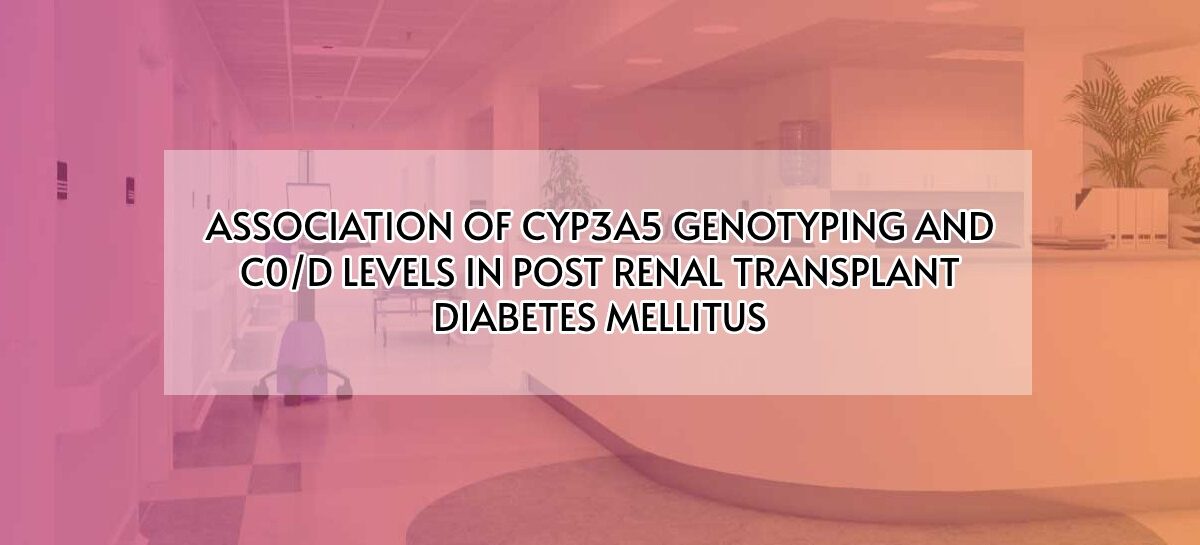INTRODUCTION:
Post transplant diabetes mellitus (PTDM) is known to occur in 4-25% of renal transplant patients, with 34.7% occurring in the first year, 46.9% and 56.2% in the 3rd and 5th year follow ups, respectively. Various factors contribute to the development of PTDM including the diabetogenic immunosuppressive medications (Corticosteroids, tacrolimus, etc), Hepatitis C virus infection, etc. PTDM has been shown to be a very strong independent predictor of mortality and graft failure.
Tacrolimus is metabolised by CYP3A5 enzyme and contributes to its bioavailabilty. They are categorised based on the allele being carried and are called expressers (CYP3A5 1/3, 1/1) or non- expressers (CYP3A5 3/3), with the latter being more common. Expressers tend to require higher tacrolimus dose, in view of the fast metabolism. C0/D ratio is the concentration to dose ratio of tacrolimus and is found to be low in expressers, thereby demanding a higher dose in them.
Previous studies elaborate on the association of CYP3A5 genotyping and C0/D ratio, whereas, further research is needed on the risk stratification of development of PTDM based on CYP3A5 and C0/D ratio associations, especially in Indian settings, which we aim to do through this study.
AIM:
To study the onset of PTDM and association of CYP3A5 genotyping and C0/D levels in the development of post transplant diabetes mellitus.
METHODS:
- A retrospective study including all renal transplant recipients at our centre from 2019-2023, who developed post transplant diabetes mellitus, defined by random glucose levels more than 200mg/dl and fasting glucose levels more than 140mg/dl, along with the need to use anti-diabetic agents in the post transplant period, excluding post transplant hyperglycemia.
- Recipients with good HLA match and negative DSA profile, did not receive induction agents.
- High risk recipients received ATG as induction agent.
- All the recipients, irrespective of their risk status received triple immunosuppression including steroid, MMF and tacrolimus, post transplant.
- Data including the CYP3A5 levels (calculated by real time PCR assay) and tacrolimus trough level at day 3 were collected.
- C0/D ratio calculated as the trough level of tacrolimus in ng/ml / the daily dose (mg).
The data was analysed for the development of PTDM, including the following outcomes:
- Time of onset of PTDM
- Association of CYP3A5 genotyping and development of PTDM
- Association of C0/D levels at day 3 with the development of PTDM
Statistical analysis was done using SPSS software version 25.0.
RESULTS:
Among a total of 110 patients, who underwent renal transplant, from 2019-2023, 14 patients were found to develop PTDM (12.7%).
Among them, 11 were males (78.5%) and 3 were females (21.5%).
The age distribution ranged from 31years to 54 years with a mean of 41.07years
PTDM was found to develop in the first year in 85.7% patients (n=12), which includes 64.1% patients who developed the same in the first month itself.
The tacrolimus trough levels measured at day 3, ranged from 4.2ng/ml to >30ng/ml with a mean of 11.7ng/ml.
C0/D ratio at day 3 ranged from 0.6 to 6.925 per mg of daily tacrolimus dose with a mean of 2.0025.
C0/D ratio at the time of onset of PTDM was ranging from 0.4 to 5.82 per mg of daily tacrolimus dose with a mean of 1.70.
The C0/D ratio at post op day 3 was categorized further as £1.5 and >1.5 (based on study by Teun van Gelder,et.al).
Among them, 6 patients had C0/D ratio £1.5 (42.8%) and 8 patients with >1.5 (57.14%).
Among the patients with C0/D ratio £1.5, 100% of patients were having CYP3A5 genotype of 1/3(expressers), whereas, among those with C0/D ratio >1.5, 62.5% of patients had CYP3A5 genotyping of 1/3 (expressers) and 37.5% of 3/3 (non-expressers).
PTDM was reported in 37.93% of the 1/3 genotype cases and 15.15% of the 3/3 genotype cases (P = 0.058), showing statistical significance.
Two patients had developed Acute cell mediated rejection prior to the development of PTDM which could have confounded the development of PTDM.
With regards to PTDM, C0/D demonstrated significant differences (p = 0.023 and p=0.008 respectively) among genotypes, with median values of 1.19(0.847-1.818) and 1.14(0.74-1.225) for 1/3 which was significantly lower than 3/3 genotype (2.04(1.87-3.185) and 2.62(2.04-3.75).
CONCLUSION:
- The onset of PTDM among our population was more within the first year post transplant, especially within the first month.
- The CYP3A5 genotypic polymorphism plays a major role in predicting the risk of development of PTDM with expressers (1/3), being more prone.
- The C0/D ratio £5 at day 3 post operatively, is an independent predictor of development of PTDM, especially in those with CYP3A5 of 1/3 genotype.
 Dr. Rashmi Shivram
Dr. Rashmi Shivram
Resident – Nephrology
Kauvery Hospital, Chennai
 Dr. R. Balasubramaniyam
Dr. R. Balasubramaniyam
Chief Nephrologist
Kauvery Hospital, Chennai
 Dr. Balaji Kirushnan
Dr. Balaji Kirushnan
Nephrologist
Kauvery Hospital, Chennai



